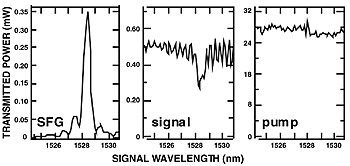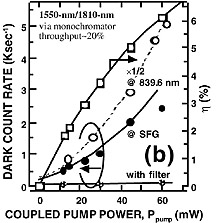Optical Science Laboratory
In recent years, the increasing demand for secure communication has
accelerated the development of a new generation of telecommunication techniques
based on quantum mechanics. Specifically, quantum key distribution (QKD)
is expected to be a key technology; practical fiber-based QKD systems have
been intensively studied in the 1500-nm wavelength band. For distributing
keys over a long distance at a high rate, efficient and low noise single-photon
detection is important. We demonstrate 1500-nm band single photon detection
with low dark count noise and a potentially high efficiency. By developing
frequency up-conversion devices based on sum-frequency generation (SFG)
in periodically poled LiNbO3 (PPLN) waveguide, which are specifically designed to use a pump wavelength
longer than that of communication-band photons, we eliminate the dark count
noise caused by parasitic nonlinear processes in the waveguide [1].
Periodic poling relaxes the wavenumber mismatch among three waves,
thus realizing quasi-phase matching (QPM), and tight mode confinement in
a LN waveguide enhances the SFG. Our devices are specifically designed
to use a pump wavelength at 1810 nm. The PPLN wafers were fabricated by
directly bonding a thin periodically poled wafer to a LiTaO3 cladding wafer. Subsequently, the bonded wafer was cut into pieces, then
a series of 7-µm thick, 6〜8-µm wide and 35 or 50-mm long ridge
stripes were defined with a dicing saw.
We observed internal conversion efficiency as high as 40 % (Fig. 1,
2), and demonstrated scaling down to the single photon level. Favored by
long wavelength pump, which never induces parasitic χ2 process thus eliminates the noise photons in 1500-nm band. By carefully
eliminate noise photons from the pump laser, a background dark count rate
less than 102 sec-1 was achieved (Fig. 2). Using the as-measured coupling of 65〜70 % of a
1500-nm wave into the waveguide, and a Si-APD efficiency of 〜57 %, we
predict an overall photon detection efficiency of about 34〜40 %.
This work was partly supported by NICT.
[1] H. Kamada, M. Asobe, T. Honjo, H. Takesue, Y. Tokura, Y. Nishida, O.
Tadanaga, and H. Miyazawa, Opt. Lett. 33 (2008) 639.
 |
 |
|||||
|
|